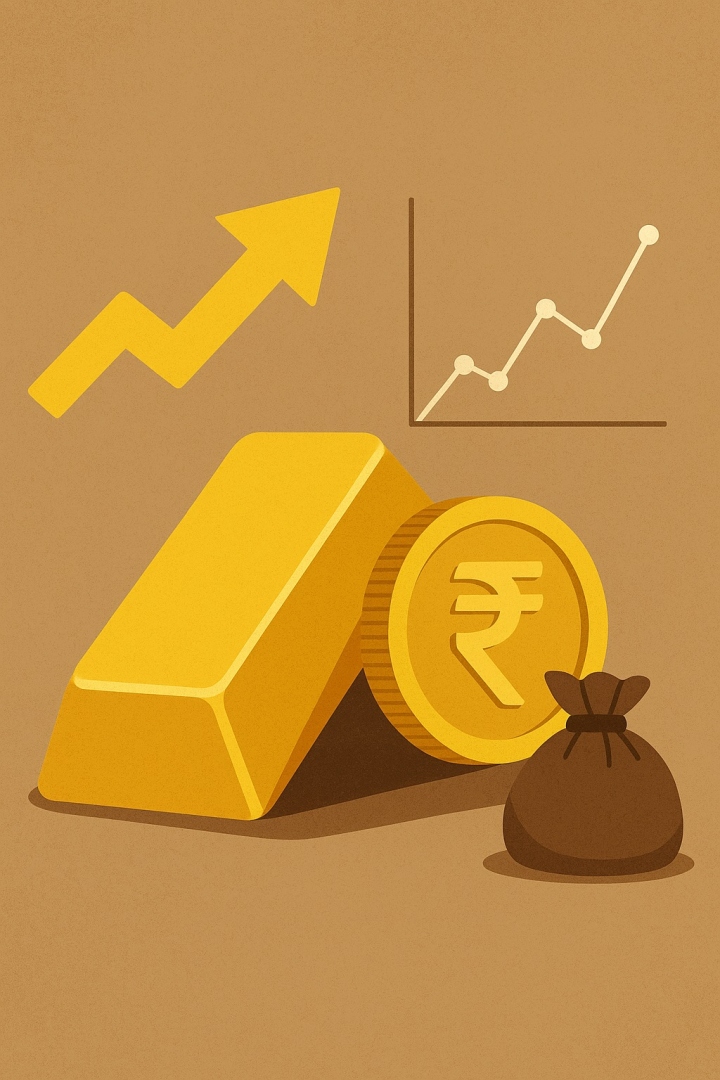
For generations, gold has held a sacred place in Indian households—seen as both an ornament of pride and a financial safety net. Festivals, weddings, and family milestones are often marked with the gifting or acquisition of gold. The deep emotional value attached to it, combined with a belief in its enduring worth, has led many to consider gold a wise long-term investment. But does gold really deliver the kind of returns we expect from a wealth-building asset?
Let’s take a closer look.
Illusion of Security
Gold is often romanticised as a “safe haven” during turbulent times. Indeed, during global crises—be it a market crash, war, or inflation spike—gold tends to perform relatively well. But this security often comes with a hidden cost: low or even stagnant returns over long stretches of time.
Many investors overlook one crucial detail—gold doesn’t generate income. It doesn’t pay dividends, interest, or rent. The only way to earn from gold is through price appreciation, which is not always consistent or guaranteed. In fact, history shows that there have been entire decades when gold barely moved in value or, worse, delivered negative real returns once inflation is factored in.
Decade That Disappointed
Consider this: Between 1993 and 2003, the price of gold barely budged. For an entire decade, those who had invested in gold saw virtually no gain. Now imagine parking your money in any other investment—say, real estate, direct equities, mutual funds, or even a fixed deposit—for ten years and earning nothing. The opportunity cost is staggering.
Even in more recent years, while gold has seen spikes in price during times of uncertainty, these are often short-lived rallies. Once stability returns, gold typically cools off. This volatile pattern makes it unreliable for systematic, long-term wealth creation.
Emotional Investing vs Strategic Investing
One of the biggest mistakes individuals make is confusing emotional comfort with financial logic. Buying gold because “our parents did it” or because “it’s auspicious” is an emotional decision—not a financial strategy. While there’s no harm in owning gold for cultural reasons or to use as jewellery, treating it as a core investment asset can be risky.
Moreover, the costs associated with physical gold—making charges, storage, insurance—eat into returns. Even digital gold and sovereign gold bonds come with limitations such as lock-in periods, taxation, and liquidity concerns.
Gold vs Growth Assets
Compare gold with equity-based investments over a 20–25 year horizon. Equity mutual funds, for example, not only generate capital appreciation but also provide compounding benefits when held over the long term. Real estate, despite its challenges, generates rental income in addition to value appreciation. Fixed income products offer predictability and stability.
Gold, on the other hand, simply sits idle—waiting for market forces to determine its value.
Role in the Portfolio - But Not the Lead Role
This is not to say gold should be completely avoided. It should still have a place in a diversified portfolio—typically as a hedge against extreme economic uncertainty or currency devaluation. However, I recommend keeping gold exposure between 5% and 10% of one’s overall asset allocation.
Investors need to remember: diversification is about balance. Overloading your portfolio with a non-income-generating, highly volatile asset like gold can hinder your long-term financial goals.
Smarter Financial Legacy
As a financial coach, I often encourage clients to reframe their relationship with gold. Instead of viewing it as the anchor of their wealth, think of it as a satellite holding—something that supports your core investments but doesn’t carry the burden of delivering primary returns.
Wealth creation is about growth, consistency, and strategy—not sentiment. Building a robust financial future means focusing on assets that work for you, day after day, year after year—not ones that shine only occasionally.
Final Thoughts
Gold may glitter, but it doesn’t always grow. Before you add another gold coin or ornament to your locker, pause and ask: is this an investment—or simply a tradition?
In today’s world of informed investing, it’s time to separate financial facts from emotional folklore. Gold can continue to be a part of your life—but let it be a symbol, not a strategy.
(The writer, as Founder and Chief Financial Coach of PlantRich & Vama PlantRich, has coached 5000 plus corporate professionals in rewriting their money story)